Charlotte Caucheteux
Jack
The Llama 3 Herd of Models
Jul 31, 2024Abstract:Modern artificial intelligence (AI) systems are powered by foundation models. This paper presents a new set of foundation models, called Llama 3. It is a herd of language models that natively support multilinguality, coding, reasoning, and tool usage. Our largest model is a dense Transformer with 405B parameters and a context window of up to 128K tokens. This paper presents an extensive empirical evaluation of Llama 3. We find that Llama 3 delivers comparable quality to leading language models such as GPT-4 on a plethora of tasks. We publicly release Llama 3, including pre-trained and post-trained versions of the 405B parameter language model and our Llama Guard 3 model for input and output safety. The paper also presents the results of experiments in which we integrate image, video, and speech capabilities into Llama 3 via a compositional approach. We observe this approach performs competitively with the state-of-the-art on image, video, and speech recognition tasks. The resulting models are not yet being broadly released as they are still under development.
Decoding speech from non-invasive brain recordings
Aug 25, 2022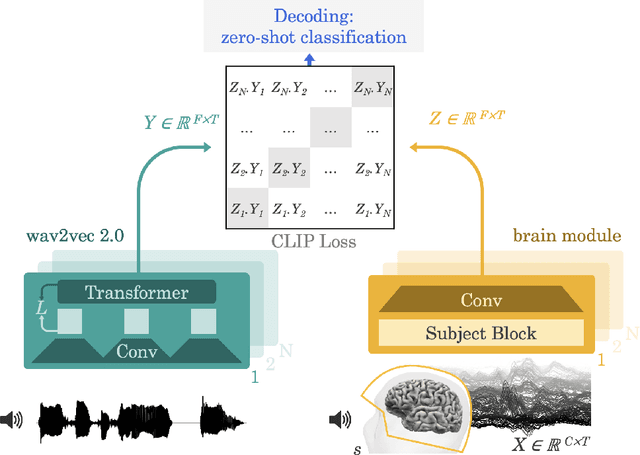

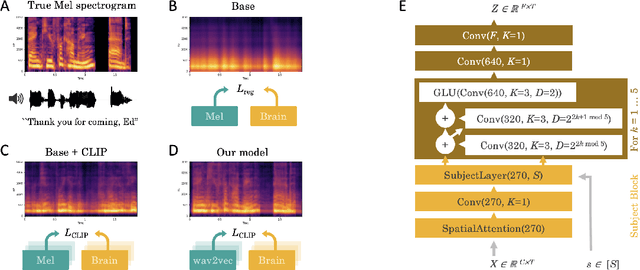

Abstract:Decoding language from brain activity is a long-awaited goal in both healthcare and neuroscience. Major milestones have recently been reached thanks to intracranial devices: subject-specific pipelines trained on invasive brain responses to basic language tasks now start to efficiently decode interpretable features (e.g. letters, words, spectrograms). However, scaling this approach to natural speech and non-invasive brain recordings remains a major challenge. Here, we propose a single end-to-end architecture trained with contrastive learning across a large cohort of individuals to predict self-supervised representations of natural speech. We evaluate our model on four public datasets, encompassing 169 volunteers recorded with magneto- or electro-encephalography (M/EEG), while they listened to natural speech. The results show that our model can identify, from 3s of MEG signals, the corresponding speech segment with up to 72.5% top-10 accuracy out of 1,594 distinct segments (and 44% top-1 accuracy), and up to 19.1% out of 2,604 segments for EEG recordings -- hence allowing the decoding of phrases absent from the training set. Model comparison and ablation analyses show that these performances directly benefit from our original design choices, namely the use of (i) a contrastive objective, (ii) pretrained representations of speech and (iii) a common convolutional architecture simultaneously trained across several participants. Together, these results delineate a promising path to decode natural language processing in real time from non-invasive recordings of brain activity.
Toward a realistic model of speech processing in the brain with self-supervised learning
Jun 03, 2022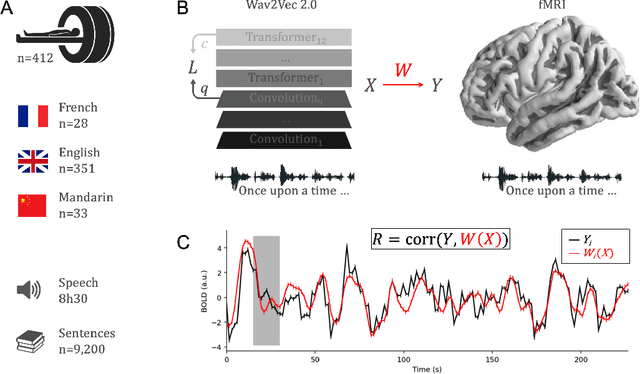

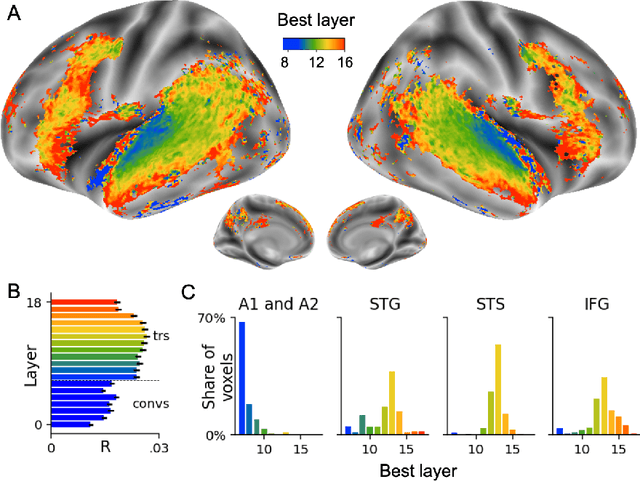
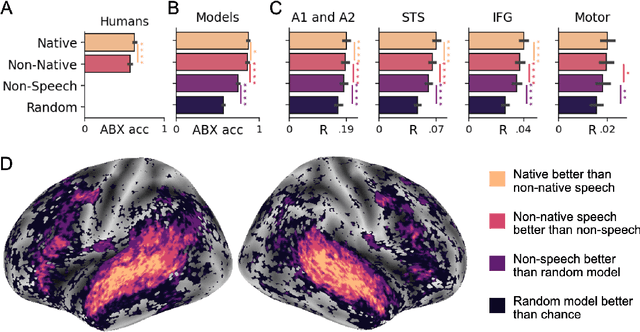
Abstract:Several deep neural networks have recently been shown to generate activations similar to those of the brain in response to the same input. These algorithms, however, remain largely implausible: they require (1) extraordinarily large amounts of data, (2) unobtainable supervised labels, (3) textual rather than raw sensory input, and / or (4) implausibly large memory (e.g. thousands of contextual words). These elements highlight the need to identify algorithms that, under these limitations, would suffice to account for both behavioral and brain responses. Focusing on the issue of speech processing, we here hypothesize that self-supervised algorithms trained on the raw waveform constitute a promising candidate. Specifically, we compare a recent self-supervised architecture, Wav2Vec 2.0, to the brain activity of 412 English, French, and Mandarin individuals recorded with functional Magnetic Resonance Imaging (fMRI), while they listened to ~1h of audio books. Our results are four-fold. First, we show that this algorithm learns brain-like representations with as little as 600 hours of unlabelled speech -- a quantity comparable to what infants can be exposed to during language acquisition. Second, its functional hierarchy aligns with the cortical hierarchy of speech processing. Third, different training regimes reveal a functional specialization akin to the cortex: Wav2Vec 2.0 learns sound-generic, speech-specific and language-specific representations similar to those of the prefrontal and temporal cortices. Fourth, we confirm the similarity of this specialization with the behavior of 386 additional participants. These elements, resulting from the largest neuroimaging benchmark to date, show how self-supervised learning can account for a rich organization of speech processing in the brain, and thus delineate a path to identify the laws of language acquisition which shape the human brain.
Long-range and hierarchical language predictions in brains and algorithms
Nov 28, 2021
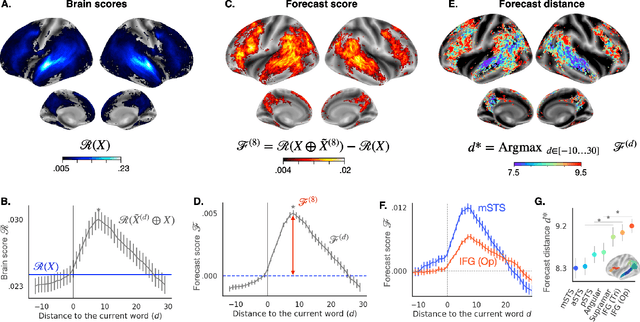
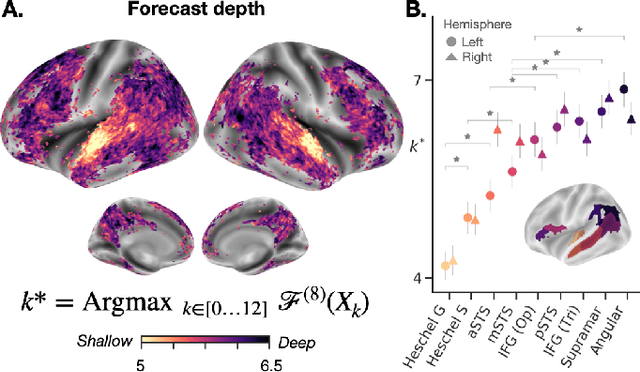
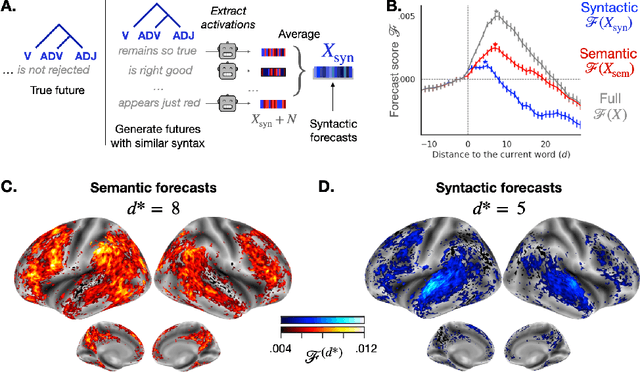
Abstract:Deep learning has recently made remarkable progress in natural language processing. Yet, the resulting algorithms remain far from competing with the language abilities of the human brain. Predictive coding theory offers a potential explanation to this discrepancy: while deep language algorithms are optimized to predict adjacent words, the human brain would be tuned to make long-range and hierarchical predictions. To test this hypothesis, we analyze the fMRI brain signals of 304 subjects each listening to 70min of short stories. After confirming that the activations of deep language algorithms linearly map onto those of the brain, we show that enhancing these models with long-range forecast representations improves their brain-mapping. The results further reveal a hierarchy of predictions in the brain, whereby the fronto-parietal cortices forecast more abstract and more distant representations than the temporal cortices. Overall, this study strengthens predictive coding theory and suggests a critical role of long-range and hierarchical predictions in natural language processing.
Model-based analysis of brain activity reveals the hierarchy of language in 305 subjects
Oct 12, 2021


Abstract:A popular approach to decompose the neural bases of language consists in correlating, across individuals, the brain responses to different stimuli (e.g. regular speech versus scrambled words, sentences, or paragraphs). Although successful, this `model-free' approach necessitates the acquisition of a large and costly set of neuroimaging data. Here, we show that a model-based approach can reach equivalent results within subjects exposed to natural stimuli. We capitalize on the recently-discovered similarities between deep language models and the human brain to compute the mapping between i) the brain responses to regular speech and ii) the activations of deep language models elicited by modified stimuli (e.g. scrambled words, sentences, or paragraphs). Our model-based approach successfully replicates the seminal study of Lerner et al. (2011), which revealed the hierarchy of language areas by comparing the functional-magnetic resonance imaging (fMRI) of seven subjects listening to 7min of both regular and scrambled narratives. We further extend and precise these results to the brain signals of 305 individuals listening to 4.1 hours of narrated stories. Overall, this study paves the way for efficient and flexible analyses of the brain bases of language.
Decomposing lexical and compositional syntax and semantics with deep language models
Mar 02, 2021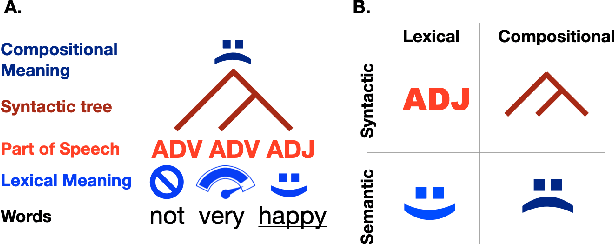
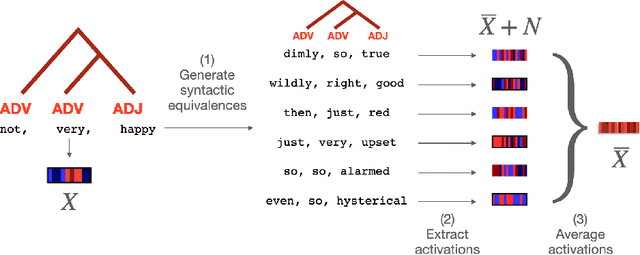

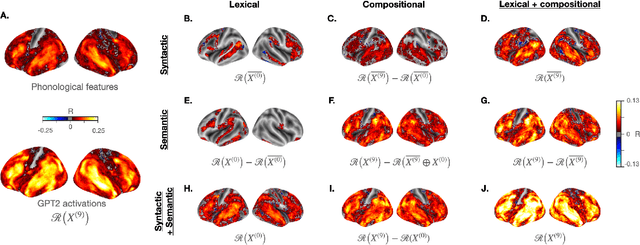
Abstract:The activations of language transformers like GPT2 have been shown to linearly map onto brain activity during speech comprehension. However, the nature of these activations remains largely unknown and presumably conflate distinct linguistic classes. Here, we propose a taxonomy to factorize the high-dimensional activations of language models into four combinatorial classes: lexical, compositional, syntactic, and semantic representations. We then introduce a statistical method to decompose, through the lens of GPT2's activations, the brain activity of 345 subjects recorded with functional magnetic resonance imaging (fMRI) during the listening of ~4.6 hours of narrated text. The results highlight two findings. First, compositional representations recruit a more widespread cortical network than lexical ones, and encompass the bilateral temporal, parietal and prefrontal cortices. Second, contrary to previous claims, syntax and semantics are not associated with separated modules, but, instead, appear to share a common and distributed neural substrate. Overall, this study introduces a general framework to isolate the distributed representations of linguistic constructs generated in naturalistic settings.
 Add to Chrome
Add to Chrome Add to Firefox
Add to Firefox Add to Edge
Add to Edge